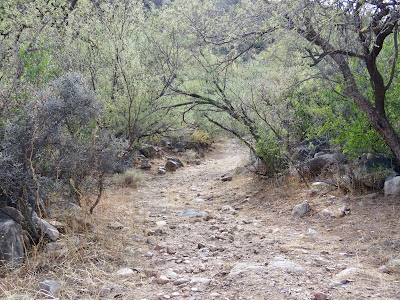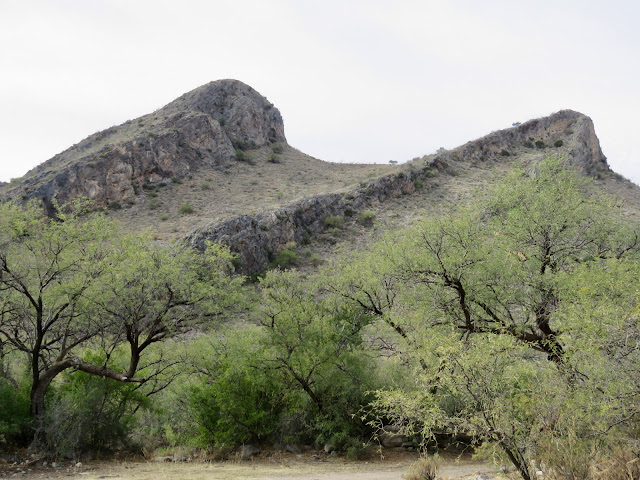When a BROWN PELICAN flew over and in front of Glenda Jones's car as she and Hinde Silver joined me to see what we might find "down south" - we definitely did not expect that bird to cross our path in that manner. On our way to Santa Gertrudis Lane in Tumacacori, we had planned to stop at Amado Ponds to see the BROWN PELICAN on our return but if time becomes a factor, we've seen the target bird so we will be able to skip that spot on our agenda.
Since I hadn't pursued the RUFOUS-BACKED ROBINs in 2017 when they were reported at Santa Gertrudis Lane, I figured I'd better take advantage of recent reports of their continued presence.
We were not disappointed. It still felt cold when we arrived at 8 a.m. and my gloves were keeping me warm as I held my binoculars...making me unprepared for the RUFOUS-BACKED ROBIN that perched up on a clear branch facing a small group of us birders - showing off the dark streaks on its white neck running down into its orange-ish chest. It sat high and proud. So I stayed still. Thus, no clear photos of any of the three (3) of them in that tree being chased by a NORTHERN MOCKINGBIRD. Mostly, twigs and leaves appear just where you might want to look at some aspect of the bird.
 |
| RUFOUS-BACKED ROBIN |
 |
| TWO RUFOUS-BACKED ROBINS IN SAME TREE |
 |
| Thanks to Glenda Jones who took this photo, you can see what the bird looks like. |
 |
| A female NORTHERN CARDINAL also enjoyed some berries. |
Although we drove into Montosa Canyon for a look around, it was extremely quiet bird-wise.
 |
| One of the trails we walked in Montosa Cyn. |
 |
| When the birds are quiet, we enjoy the scenery - taken from within Montosa Canyon. |
 |
| When looking into the trees and you see this bird - it stops you in your tracks. It's checking out sapsucker holes looking for insects that may have gotten trapped in the sap. |
 |
| Catching its profile is not nearly as colorful as seeing its bright red belly. |
 |
| PAINTED REDSTART |
 |
| Glenda & Hinde (L-R) slightly off trail at the top of the loop. |
A gnatcatcher was calling, but it wasn't the BLACK-CAPPED GNATCATCHER we were hoping to see. Two women from Dallas were also hoping to see it so five of us were now looking for this rarity. When we landed on it, we did a quick evaluation since we all knew either the Blue-Gray or Black-tailed Gnatcatchers. The bill on this one was definitely longer than on the local species of gnatcatchers (also present by the way) and my observation gave me my best ever view of its graduated under-tail white feathers. By the time those seconds (a minute maybe) had gone by, the bird took off with no photo proof - but a solid sighting that was worth more than a photo to me this time.
A RED-NAPED SAPSUCKER returned to its tree at the corner of Proctor Road and the paved trail.
With time left for a visit to Santa Rita Lodge, we drove up the road to see what birds might be visiting the multiple feeders at that location.
 |
| The "clownish" ACORN WOODPECKER (several of them entertained us with their antics) |
 |
| WILD TURKEY forage on the ground below the feeders (only 2 there during our visit)
Although numerous hummingbird feeders were available, the number of hummingbirds was slim. ANNA'S HUMMINGBIRD was the most frequent visitor and the only one I identified as I watched the action all over the birding site: MEXICAN JAY, PINE SISKIN, LESSER GOLDFINCH, DARK-EYED and YELLOW-EYED JUNCO, WHITE-BREASTED NUTHATCH and BRIDLED TITMOUSE.
It was a grand day!
* * *
View this checklist online at http://ebird.org/ebird/view/checklist/S41694273
View this checklist online at http://ebird.org/ebird/view/checklist/S41694874
View this checklist online at http://ebird.org/ebird/view/checklist/S41695053
View this checklist online at http://ebird.org/ebird/view/checklist/S41695680
View this checklist online at http://ebird.org/ebird/view/checklist/S41696095
|




Indeed a great day. My first trip to the canyon area this winter - always special.
ReplyDelete